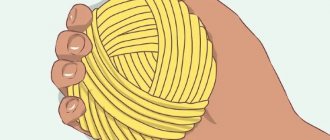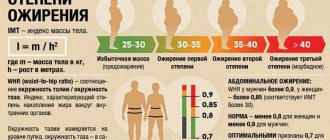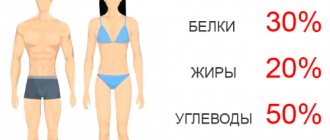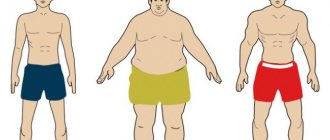Waist size in men is not only an important indicator of how the figure develops and what is the state of health. This is also one of the necessary measurements in choosing the right clothing size. Therefore, many people actively use size tables with waist measurements for men.
When starting the process of losing weight, going on a diet, planning to order clothes, as well as doing exercises at home or in the gym, it is important to accurately and correctly measure the contours of the body. Why? When deciding to lose weight or build muscle, you need to know your starting point. For this purpose, tables with normal age and weight are used to measure waist size in men.
How to measure
This type of measurement is not difficult, but there are a few basic principles to keep in mind. First of all, correct body position is important.
The waist is slightly below the level of the ribs and just above the navel. When measuring yourself, it is better to do it in front of a mirror. A correctly taken measurement is obtained when measuring a centimeter around the narrowest part of the body. The centimeter is applied horizontally. In addition, during the measurement you should be in a standing position, you must first exhale. Moreover, you need to ensure that the centimeter does not fit too tightly or too loosely around the body. It is best to take measurements with an accuracy of 0.5 cm. Of course, measurements are never taken while wearing clothes; in order for the result to be accurate, you need a naked body. Measurements should not be taken immediately after a heavy meal. The results in this case will be erroneous.
After several months of struggling with excess pounds, after liters of sweat shed in the gym, sometimes you get the feeling that little has changed in your silhouette. Checking the waist size in men using a table approximately every 2 weeks allows you to understand whether the training is actually bringing results. The centimeter doesn't lie.
Measuring is a much more accurate tool for tracking progress than weighing yourself. Human body weight is constantly subject to small or large changes. This is influenced by the fact that we live under stress, sometimes we eat more than we need, we drink a lot, or, conversely, we suffer from dehydration, for example, during illness. Weight is constantly changing.
What foods should you avoid?
But food that clogs the body and gives the body excess calories, while not satisfying the feeling of hunger, should not be present in the house. Undoubtedly, you need to know what constitutes junk food.
This includes:
- fast food;
- semi-finished products;
- instant food products;
- sweet;
- roast;
- very salty;
- dried;
- smoked meats
It is important to remember that flour is also harmful (especially for men). And of course, this applies to any alcoholic beverages. If all this gets into the body, the problems will be much more serious than those described earlier in the text.
Rules
They examine the waist size of men for the clothing size they are going to select in the morning on an empty stomach, before the person eats or drinks anything. They do not measure clothing.
You need to stand with your feet hip-width apart, relax your body, including your gluteal muscles, and breathe calmly. You will need to straighten your back. It is important not to pull your stomach in too much.
When taking measurements, it is best to start at the top of the body and work your way down.
To compare waist size in men with the norm in the table, measurements are taken at the narrowest point of the torso. It is necessary to ensure that the person does not suck in his stomach. Waist circumference is measured approximately at the navel or slightly below.
OTHER CAUSES OF FULL WAIST
When a man reaches forty years of age, sex hormones are produced in smaller quantities.
Testosterone is not only responsible for sexual desire, it controls the activity of most organs. Thanks to him, a man has an active metabolism, that is, metabolism. Therefore, a sufficient amount of this hormone guarantees the absence of obesity. A decrease in testosterone causes a corresponding increase in estrogen. This is how excess abdominal fat appears, due to which the male hormone turns into a female one. At the same time, the hormone leptin is formed, which suppresses the formation of testosterone in the testicles. Sometimes the cause of obesity is simple stress. Mental overload leads to a change in the balance of hormones to suppress a critical reaction to the situation, resulting in the storage of large amounts of fat. Often a man begins to overeat to get rid of negative emotions, because delicious food gives pleasure and relaxes a person. At the same time, there is no real hunger. With age, body weight also increases for most men. This is due to a slowdown in metabolism and cessation of previous activity. Quitting cigarettes provokes eating sweets as compensation. In addition, when the body undergoes restructuring due to the lack of nicotine, metabolic disruptions occur.
The problem of a fat belly in men is not only an unsightly aesthetic appearance. The matter is much more serious and concerns the duration and quality of his life. An imperceptible increase in centimeters in the waist area is real years of life that disappear under layers of fat.
Meaning
Most people think that body weight is an indicator that determines the effectiveness of training or the degree of obesity. However, in reality, mass says little about the results of training. Body contour measurements are important; athletes recommend taking them every 1-2 weeks in the morning on an empty stomach. Based on their changes, the training program is adjusted, as well as the amount of calories in the diet. Or they select suitable clothes and sew new ones. Measurements of body contours should be performed in a standing position, slightly tensing the muscles, to avoid possible errors due to excessive relaxation of the body.
What can you eat?
What does this include? The menu should contain as many vegetables and fruits as possible. Meat is also possible, but only in limited quantities and preferably low-fat varieties (for example, poultry). And as an alternative to red fatty meat, doctors advise men to eat fish. There is no need to exclude dairy from your diet. It is only advisable to reduce the fat content of milk to 1.5%.
In terms of changes in diet, it should be in favor of consuming proteins, vegetable fats and complex carbohydrates instead of animal fats and simple carbohydrates.
Relationship with mass
To make it easier to figure out which direction to move, there is a norm table for men’s waist size. It takes into account the relationship of this indicator directly with body weight.
In order to compare a man’s waist size with the norm in the table, you only need a centimeter. But to determine the degree of obesity, you also need scales. The calculation is made as follows: body weight in kilograms is divided by height expressed in meters. However, there is a second method that uses waist measurements for men, the norm table.
It checks the ratio of waist circumference to hip circumference. You will need to measure your waist circumference (3-5 cm above the navel), as well as your hip circumference at the widest point. Then divide the waist circumference by the hip circumference. For example, a person with a waist circumference of 86 cm and a hip circumference of 96 cm has an index of 0.8.
This is how an indicator called WHR (Waist/Hip Ratio) is calculated. It expresses the ratio of waist circumference to hip circumference and determines body type and degree of obesity. If it is equal to/above 0.8 in women or equal to/above 1.0 in men, we are dealing with apple-type obesity, also called abdominal obesity. This is the most dangerous type of obesity, which is prone to the development of cardiovascular diseases and many other serious ailments. If the indicator value is less than 0.8 in women and 1.0 in men, we are talking about less serious obesity - pear-type obesity. But this does not mean that it does not increase health risks.
VISCERAL OBESITY
To determine the presence of abdominal-visceral obesity, you need to measure your waist and hip circumference. A waist circumference of more than 94 centimeters is a danger signal. Armed with a tailor's measuring tape, you should measure your waist a couple of centimeters above the navel. Hip circumference should be measured at its widest part. If the ratio of these values is 1.0 or more, then you should be concerned about your health. With a value of 0.9, the man is normal, has good potency and has virtually no risk of developing prostate cancer.
You can do without calculating body parameters; you just need to stand up straight, squeeze a fold of belly fat between your fingers and measure. A size greater than two centimeters makes you wary and requires you to start taking action to reduce weight.
The shape of the abdomen in men varies:
- loose, shapeless, fat accumulations under the skin;
- hard, ball-like;
- egg-shaped, so-called beer belly. In fact, this is visceral obesity, the most dangerous to health.
Abdominal obesity is typical mainly for men. It is characterized by the deposition of fat around internal organs. This indicates an increase in metabolic disorders. Subsequently, the visceral type of obesity leads to the development of glucose tolerance and the threat of diabetes mellitus. There is an increase in the proportion of cholesterol, leading to the development of atherosclerosis and heart disease. This type of obesity becomes most relevant for men during the period of decreased testosterone production, which occurs after thirty years.
What does waist circumference mean?
Waist circumference itself is also an important indicator of health. The normal waist circumference for women is 80 cm; for men, 94 cm is considered normal. Values above 88 cm in women and 102 cm in men indicate the possibility of developing breathing problems, hypertension, high cholesterol, and the risk of developing diabetes and heart failure. It is also important to study the accumulation of subcutaneous fat.
Cereals and water
Proper nutrition also includes a sufficient amount of grains. In addition to the fact that cereals provide the body with the necessary nutrients and give a lot of energy, they saturate and make you full for a long time. Eating grains improves digestion. Therefore, porridges made from various cereals are simply irreplaceable in the diet.
In addition, doctors recommend trying separate meals. Adequate water consumption, about 8 glasses every day, will help establish the required metabolism. And this, in turn, is a big step towards reducing fat deposits and a beautiful appearance. Increasing the amount of fiber in your diet will also be helpful in this regard. This is what healthy and wholesome food is all about.
Subcutaneous fat examination
You need to relax your stomach, and then, at a close distance from the navel, pinch the skin between two fingers. If it has a thickness greater than 2.5 cm, this means that the accumulation of subcutaneous adipose tissue is excessive. It is necessary to get rid of it in the near future.
These simple measurements will indicate whether there is cause for concern and how urgent action needs to be taken to maintain health and well-being.
Men's waist size: norm and deviations
Every extra five centimeters in the waist area increases the likelihood of premature death by 17% in men. Why is belly fat so dangerous? Because this sign indicates the presence of the most harmful type of obesity - abdominal. Waist size perfectly characterizes the level of men's health and is a prognosis for longevity.
How often should you measure your waist?
It is recommended to examine this issue at least twice a week. When fat accumulates in the abdomen - on and around the internal organs - fat cells release chemicals that cause inflammation and produce proteins associated with appetite. In addition, insulin resistance increases and the likelihood of metabolic disorders increases as inflammation affects muscle and liver cells. Their functions may be inhibited. Meanwhile, the natural appetite regulation system does not work properly, leading to overeating and increased belly fat.
Measuring your waist with a tape measure is a good indicator of the amount of belly fat.
Change in diet
In this case, you should be extremely careful with diets. This is because we are dealing with abdominal fat. This fat is deposited around internal organs (mainly in men) due to metabolic disorders in the body. Since diet can provoke such a disorder, it is better not to risk it.
Instead, it is recommended to reduce your daily caloric intake by just 300 kcal. The frequency of meals should also be changed. It is recommended to eat little and often, while reducing the energy value of each serving. Under no circumstances should you sharply restrict your diet. This “shock therapy” will not lead to anything good.
Correct nutrition is one in which the diet is balanced and based on foods that benefit the body.
conclusions
- Body composition indices obtained using radiation methods do not have advantages over classical anthropometric indices.
- Among classical anthropometric indices, waist-to-height ratio (WHtR) was found to be the most reliable for predicting metabolic syndrome in the Korean population.
Source:
- Kang SH, Cho KH, Park JW, Do JY. Comparison of waist to height ratio and body indicators for prediction of metabolic disturbances in the Korean population: the Korean National Health and Nutrition Examination Survey 2008–2011. BMC Endocrine Disorders
. 2015;15:79. doi:10.1186/s12902-015-0075-5.
Patients and methods
Sample
For the analysis, we used data from the National Korean Health Organization - a nationwide multi-stage, stratified survey of a representative sample of the entire South Korean population under the “leadership” of the Korean Center for Disease Control and Prevention for 2008-2011
- Total number of participants: 37,753 14,533 were excluded due to missing information on renal function and metabolic markers
- 6,019 had missing information on body composition
- 1,236 were under 18 years of age
Parameters studied
Clinical and laboratory data collected from the survey:
- age
- floor
- the level of education
- smoking mode
- amount of daily alcohol consumption
- physical activity
- waist circumference (cm)
- WHtR
- BMI (kg/m2)
- lean mass index (kg/m2)
- fat mass index (kg/m2)
- body fat mass index (kg/m2)
- skeletal muscle mass index (kg/m2)
- mineral composition of bone tissue (kg/m2)
- systolic and diastolic blood pressure levels (mmHg)
- Fasting glucose levels (mg/dL)
- cholesterol, triglycerides, HDL (mg/dl)
- glomerular filtration rate (ml/min/1.72m2)
Measurement methods
- Glucose, cholesterol, triglycerides, and HDL levels were measured using a Hitachi Automatic Analyzer 7600 (Hitachi, Japan) using an enzyme assay (Sekisui Co., Japan).
- Serum creatinine levels were measured using a Hitachi Automatic Analyzer (alkaline picrate, Jaffekinetic).
- Glomerular filtration rate was determined using the CKD-EPI equation (2009).
- Chronic kidney diseases were determined according to the following indications: glomerular filtration rate <60 ml/min/1.73 m2
- proteinuria (greater than or equal to 1+)
- Metabolic equivalent (MET) minutes per week were calculated from the International Physical Activity Questionnaire. Depending on the results, 3 groups were identified (<3000 MET, 3000-6000 MET, >6000 MET minutes per week).
- heavy smokers (> 30 pack/years)
- do not drink alcohol (did not drink alcohol in the last year),
- Standing height was measured while standing, barefoot, feet together, arms at sides, and back against a wall according to SECA 225 (SECA, Hamburg, Germany).
- lean mass
- According to the criteria of the recommendations of the National Cholesterol Education Program Adult Treatment Panel III, 3 or more signs indicate the presence of metabolic syndrome. Arterial hypertension was defined as 130/85 mm Hg, a history of hypertension or the use of antihypertensive drugs.
- Elevated glucose levels were defined as >100 mg/dL or a history of diabetes mellitus.
- Reduced HDL levels are considered <40 mg/dL in men and less than 50 mg/dL in women.
- Elevated triglyceride levels are considered >150 mg/dL.
- Abdominal obesity was defined as a waist circumference greater than 90 cm in men and greater than 80 cm in women.
Statistical analysis
- The obtained data were analyzed using SPSS version 19 (SPSS, Chicago, IL, USA).
- The distribution of continuous random variables was checked using the Kolmogrov-Smirnov test.
- Nonparametric tests were assessed using the Mann-Whitney U test.
- Also, to analyze the variables, the Pearson goodness-of-fit test and the Fisher test were used.
- Multivariate logistic regression analysis was used to estimate odds ratios, and 95% confidence intervals were used to determine the relationship between various parameters and metabolic syndrome.
- Covariates potentially influencing the outcome (age, smoking, physical activity, and average daily alcohol consumption) were included in the multivariate models.
- Model 1 was unadjusted, model 2 was adjusted for age, smoking, physical activity, and average daily alcohol consumption.
- Components of metabolic syndrome were analyzed using analysis of covariance.
- Differences in the model's ability to differentiate between participants with and without metabolic syndrome were examined using the area under the ROC curve (AUROC).
- AUROC analysis is also performed to calculate cutoff values, sensitivity and specificity. The best risk threshold was determined by the maximum of the Youden index in AUROC.
- AUROC was calculated using MedCalc version 11.6.1.0 (MedCalc, Mariakerke, Belgium).
- The level of statistical significance is p<0.05.
What's the problem with BMI?
Calculating BMI is a simple measurement and is widely used. However, the main factor is the person's height and is not taken into account:
- hip and waist measurements;
- features of the figure and fat distribution;
- muscle mass.
These indicators also have an impact in determining normal weight. For example, athletes have high BMIs despite being in excellent physical shape. This is explained by a large amount of muscle mass, and this does not mean being overweight.
BMI rather gives an approximate understanding of whether a person can be called a healthy weight, rather than defining ideal parameters. BMI measurements are also useful for statistics when researchers calculate trends. This indicator should not become the only one when assessing a person’s normal weight. At a minimum, it is worth considering additional factors.
Patients and methods
- Data from the National Korean Health Organization for 2008-2011 were analyzed.
- The study included 15,965 participants.
- Body mass index (BMI) was calculated as body weight divided by height (m) squared.
- Waist-to-height ratio (WHtR) was calculated as waist circumference divided by height.
- Lean mass (LM) was studied using DEXA
- fat mass (FM)
- trunk fat mass (TFM)
- bone mineral mass (BMC)
Hypersthenic version of the male figure
The endomorph is crumbly, its body is wide, round and soft. The hypersthenic body type involves short stature and short, thick legs and arms. The main feature of this group of representatives of the stronger sex is their fairly strong legs. This is why stocky athletes achieve good results by training primarily the lower torso (deadlifts, squats, etc.). Due to the fact that the metabolism is weak, weight can very easily increase, but the extra pounds are reluctant to go away. The main advantage of this type is an easy gain of muscle mass, but with it comes fat if weight gain occurs due to poor nutrition. Distinctive features of endomorphs:
- Wrist circumference is more than 20 cm.
- Stocky figure: wide hips, shoulders, waist, short legs.
- Short neck, fat deposits between the shoulder blades, on the stomach.
- A variety of sports supplements are not necessary; only the amount of protein in the diet should be sufficient.
- When training, do not forget about cardio training (or circuit training for fat burning) and watch what you eat.
Particular attention should be paid to nutrition. Many athletes make the mistake of completely giving up food and resorting to starvation diets. Fasting can “eat” both fat and muscle mass, and the lost weight soon returns, bringing with it more and more layers of fat.
An example of endomorphs among bodybuilding stars was Jay Cutler.
How to determine the ideal proportions of a male body
The ideal proportions of a male body are considered to be tall height, a V-shaped torso and compliance with certain parameters, which may differ for men of different ages. Nationality and occupation also leave some imprint on the standard of beauty. At the same time, an athletic figure, broad shoulders and chest, sculpted muscles combined with narrow hips have always attracted the attention of the fair half of humanity.
WEIGHT LOSS STORIES OF STARS!
Irina Pegova shocked everyone with her weight loss recipe: “I lost 27 kg and continue to lose weight, I just brew it at night. » Read more >>
The path to an ideal body begins with measuring it. That is, before you change anything about yourself, you need to determine which part of the body requires improvement.
For a more correct result of measurements, they should be carried out in the morning, since after waking up, that is, during the period when rested muscles are relaxed, the body’s indicators will be as accurate as possible. During the day, various loads can greatly distort the data. Only those who, for some reason, experience swelling in the morning can ignore this rule.











